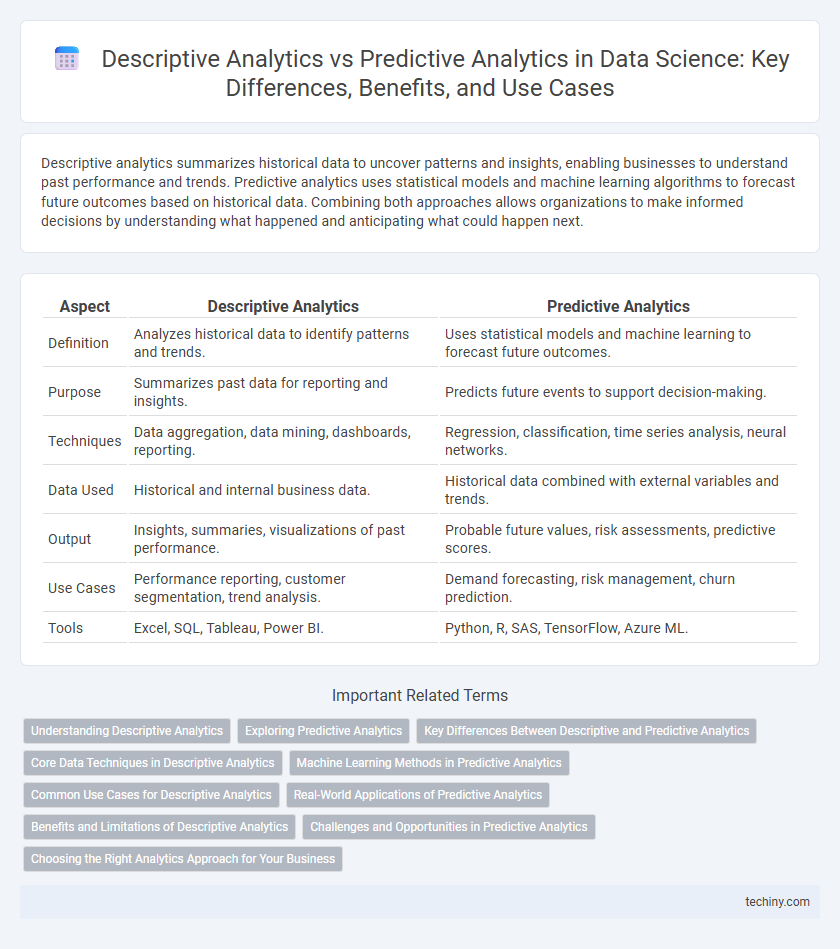Descriptive analytics summarizes historical data to uncover patterns and insights, enabling businesses to understand past performance and trends. Predictive analytics uses statistical models and machine learning algorithms to forecast future outcomes based on historical data. Combining both approaches allows organizations to make informed decisions by understanding what happened and anticipating what could happen next.
Table of Comparison
| Aspect | Descriptive Analytics | Predictive Analytics |
|---|---|---|
| Definition | Analyzes historical data to identify patterns and trends. | Uses statistical models and machine learning to forecast future outcomes. |
| Purpose | Summarizes past data for reporting and insights. | Predicts future events to support decision-making. |
| Techniques | Data aggregation, data mining, dashboards, reporting. | Regression, classification, time series analysis, neural networks. |
| Data Used | Historical and internal business data. | Historical data combined with external variables and trends. |
| Output | Insights, summaries, visualizations of past performance. | Probable future values, risk assessments, predictive scores. |
| Use Cases | Performance reporting, customer segmentation, trend analysis. | Demand forecasting, risk management, churn prediction. |
| Tools | Excel, SQL, Tableau, Power BI. | Python, R, SAS, TensorFlow, Azure ML. |
Understanding Descriptive Analytics
Descriptive analytics involves analyzing historical data to identify patterns, trends, and insights that explain past performance. It uses techniques such as data aggregation, data mining, and reporting to summarize key metrics and support decision-making. Understanding descriptive analytics is crucial for establishing a data-driven foundation before advancing to predictive models.
Exploring Predictive Analytics
Predictive analytics leverages historical data, statistical algorithms, and machine learning techniques to forecast future outcomes and trends with high accuracy. It goes beyond descriptive analytics, which summarizes past data, by enabling data-driven decision-making through predictive models such as regression analysis, classification, and time series forecasting. Key applications include customer behavior prediction, risk assessment, and demand forecasting, which drive strategic initiatives and enhance operational efficiency.
Key Differences Between Descriptive and Predictive Analytics
Descriptive analytics focuses on summarizing historical data to identify patterns and trends, using techniques such as data aggregation and visualization to understand what has happened. Predictive analytics employs statistical models and machine learning algorithms to forecast future outcomes based on historical data, enabling data-driven decision-making. Key differences include the temporal focus--descriptive analyzing past data, predictive estimating future events--and the analytical depth, with predictive analytics requiring advanced modeling techniques beyond descriptive summaries.
Core Data Techniques in Descriptive Analytics
Descriptive analytics primarily utilizes techniques such as data aggregation, clustering, and data visualization to summarize historical datasets and uncover patterns or trends. Core data methods include measures of central tendency, frequency distribution, and correlation analysis to provide insights into what has happened within the data. These foundational techniques enable businesses to make informed decisions by understanding past performance and current states before applying advanced predictive models.
Machine Learning Methods in Predictive Analytics
Descriptive analytics summarizes historical data to identify patterns and trends using techniques like data aggregation and visualization. Predictive analytics leverages machine learning methods such as regression analysis, decision trees, and neural networks to forecast future outcomes based on historical data. These algorithms enable data scientists to build models that predict customer behavior, detect anomalies, and optimize decision-making processes in various industries.
Common Use Cases for Descriptive Analytics
Descriptive analytics is primarily used to summarize historical data, providing insights into past behaviors and trends such as customer purchase patterns, sales performance, and website traffic analysis. Common use cases include generating business performance reports, identifying top-selling products, and analyzing operational metrics to optimize processes. These insights help organizations make informed decisions by understanding what has happened in their data.
Real-World Applications of Predictive Analytics
Predictive analytics leverages machine learning algorithms and historical data to forecast future trends, enabling businesses to optimize inventory management and reduce operational costs. In healthcare, predictive models identify high-risk patients, facilitating early interventions and personalized treatment plans that improve patient outcomes. Financial institutions use predictive analytics to detect fraudulent transactions and assess credit risks, enhancing security and lending decisions.
Benefits and Limitations of Descriptive Analytics
Descriptive analytics offers the benefit of transforming raw data into meaningful patterns and summaries, enabling organizations to understand past events and identify trends with clarity. Its limitations include a lack of foresight, as it cannot predict future outcomes or provide insights into potential scenarios beyond historical data analysis. This analytics type serves as a foundational tool ideal for reporting and dashboard creation but requires integration with predictive methods for comprehensive decision-making.
Challenges and Opportunities in Predictive Analytics
Predictive analytics faces challenges such as data quality issues, model overfitting, and the complexity of integrating diverse data sources, which can hinder accurate forecasting. Opportunities arise from advances in machine learning algorithms, increased computational power, and the availability of big data, enabling more precise predictions and real-time decision-making. Organizations leveraging predictive analytics can improve risk management, customer segmentation, and operational efficiency despite these challenges.
Choosing the Right Analytics Approach for Your Business
Descriptive analytics focuses on summarizing historical data to identify patterns and trends, providing businesses with insights into past performance. Predictive analytics uses statistical models and machine learning algorithms to forecast future outcomes, enabling proactive decision-making and strategic planning. Selecting the right analytics approach depends on business objectives, data availability, and the need for either understanding past performance or anticipating future events.
descriptive analytics vs predictive analytics Infographic

 techiny.com
techiny.com